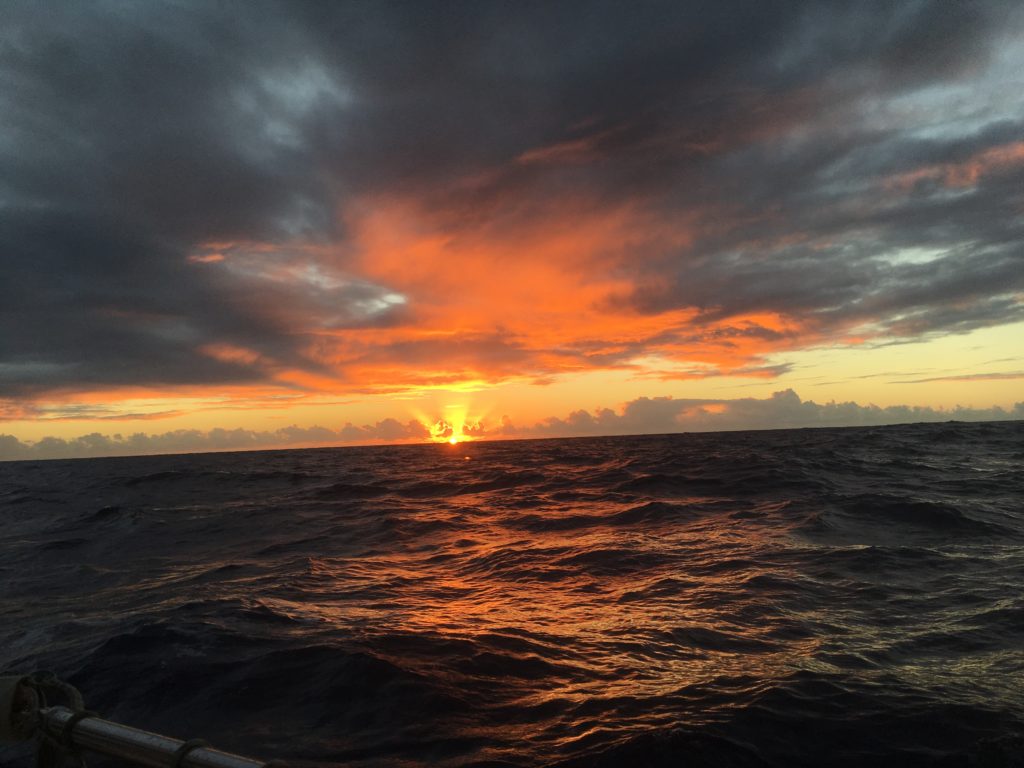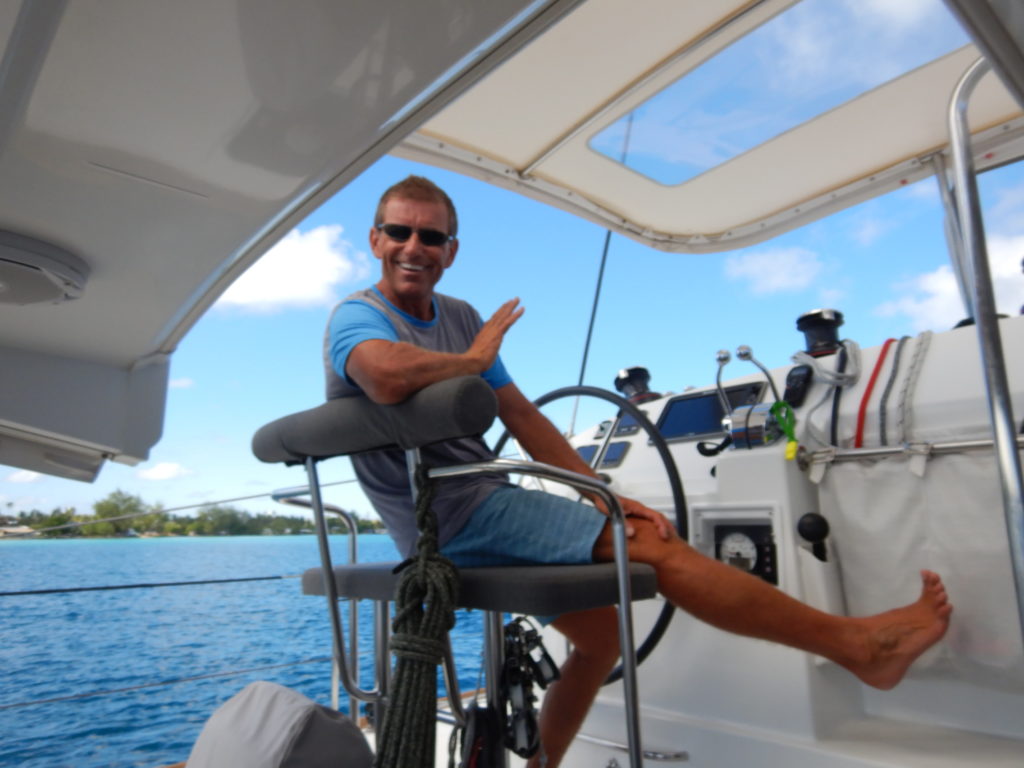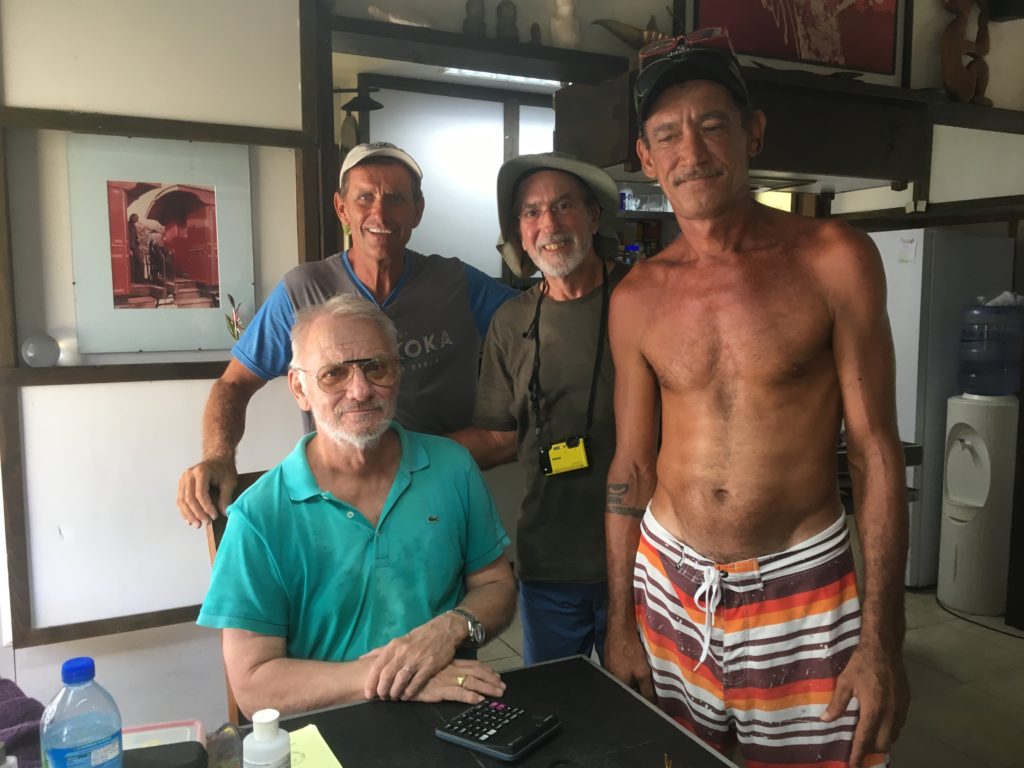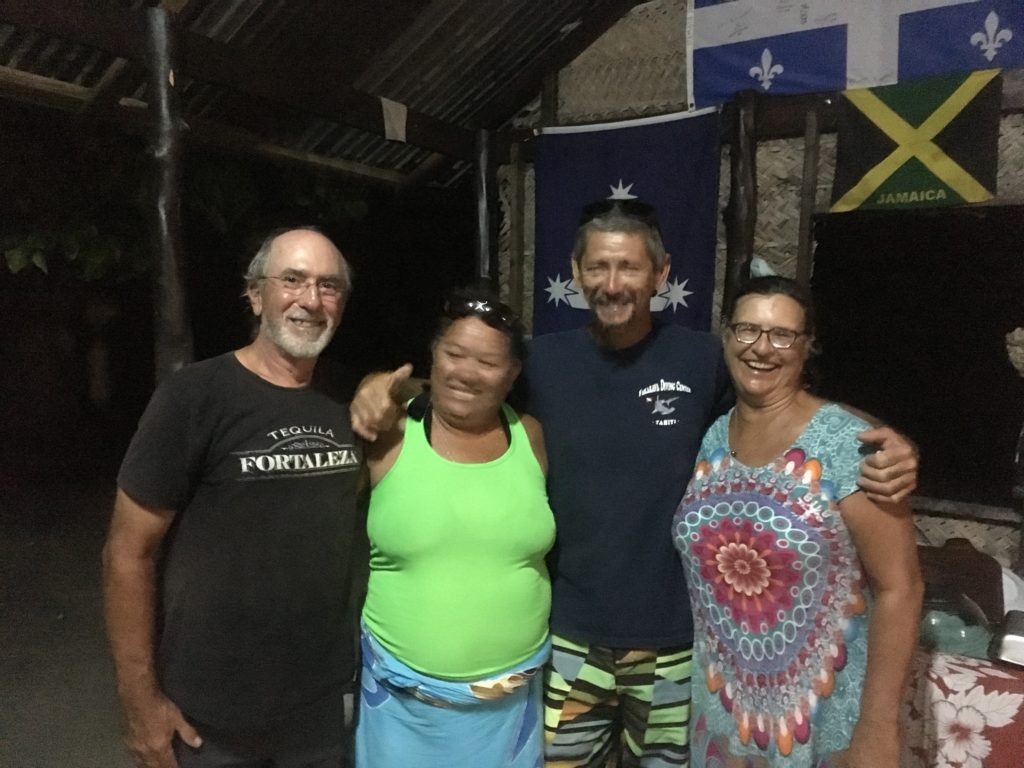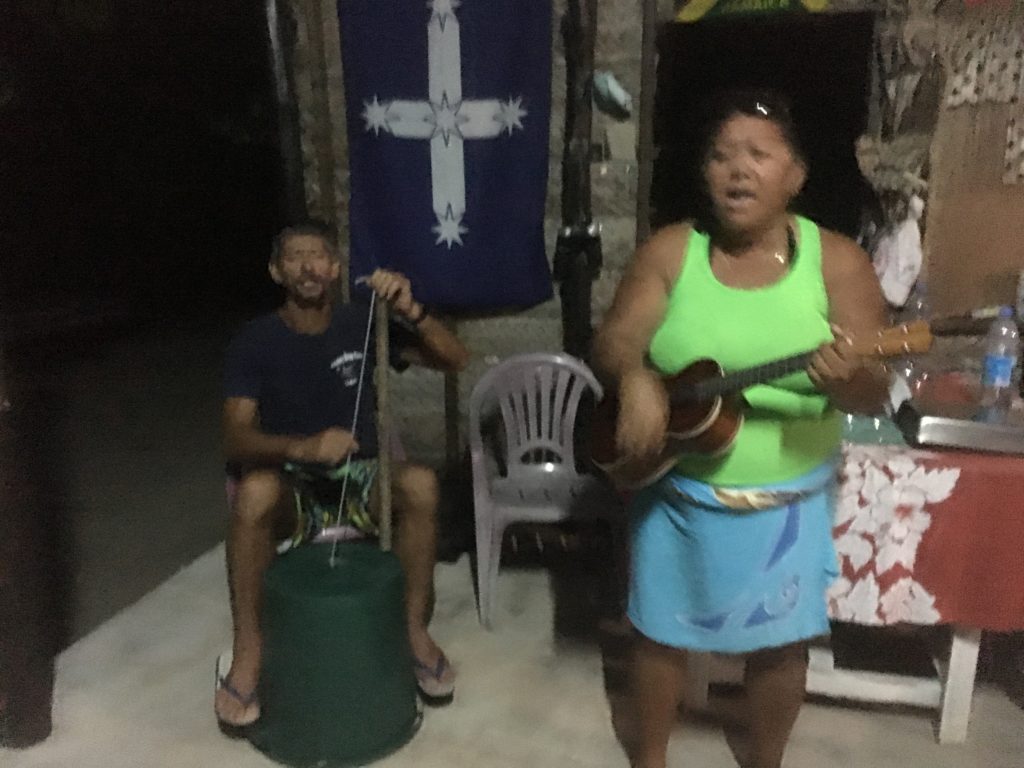The Tuamotu archipelago sits over 500 miles SW from the Marquesas. It consists of more than 100 “atolls.” An atoll is a roughly circular lagoon surrounded by coral reefs called motus. This archipelago represents the geologically oldest in French Polynesia. The volcanic islands that once existed there have entirely sunk back into the ocean, leaving only the coral reefs that built up around them. Some of the motus are big enough and wide enough to support houses, palm trees and infrastructure, although we mused that the motus are so narrow in places that it would be possible to have a view from your front deck of the lagoon, and a view from your rear deck of the ocean! Generally the passes between motus are too shallow to get through, but on most atolls, there is at least one pass deep enough to get in and out of the lagoon. The problem is, the entire force of the swells and tides has to squeeze through this one pass, making the current in the pass extremely strong. The land is very flat and not very productive because it consists mostly of ground coral. There is no water source on the atolls except rain catchment systems. Fortunately, it rains fairly frequently. The lagoons often contain “bommies,” coral heads that almost reach the surface, making navigation inside the lagoon difficult.
Inspite of these challenges, some enterprising souls choose to make their living here, mostly fishing, coconut farming, or pearl farming. Yes, this is the home of the famous black pearl. More on that later. Some live here because their families have lived here for generations and they can carve out a living on the property they have inherited, no matter how strenuous the work. But the first impression we westerners have of any of these atolls is the iconic “stranded on an island in the South Pacific” image, with a single palm tree on a small patch of white sand surrounded by translucent aqua-colored water. Who wouldn’t want to live there? Besides, the big draw of the Tuamotu is the snorkeling and diving. The coral we saw was incredibly vibrant and alive, and snorkeling around reefs was like snorkeling inside of an aquarium. There is nothing like it. The water is warm and crystal clear; you could be there for hours and hours, over and over again, day in and day out without getting bored. Of course, Rick and I are such newbies to this snorkeling stuff that we could hardly name anything we saw, but the beauty was just overwhelming. Friends more experienced than we are said they had never seen such abundance and diversity before in their lives. It was an octupus’s garden. Even the sharks were friendly, or at least they left us alone.
Getting There
We sailed 562 miles to get to the Tuamotu from Nuku Hiva. We started out with good winds on a broad reach leaving the Marquesas. We passed through several squalls but nothing too violent. As we moved southward, the wind came more from the south and we found ourselves on a less comfortable beam reach, but nothing we couldn’t handle with a little reefing. The moon was full and bright, making the nights a little less foreboding. We made 133 nm that first day, pretty good for Cool Change. The second day we had lighter winds; a little too light for Charlie, our windvane, so we used our autopilot, and still maintained a 5 knot average speed. At night a bird hit our wind generator blades and fell into the water even though Rick tried to scare him off. We found blood on the blades the next day. Sorry, bird! About the third day out, we lost our wind so we turned on the engine and ran the watermaker. The wind came up again that night and we had a number of squalls pass over with greater than 25 knots, with big seas and rain. As a result, we were down to just the staysail by the time the wind slowed enough to roll out the jib again. We were traveling way over hull speed, at 7 knots, whenever a squall hit. Over the early morning hours, we continued in a bouncy and uncomfortable ride, with occasional splashes into the cockpit, but by later that morning, the wind was down to 16 knots and we had deployed the mainsail again.
We had planned for a five day voyage but we were making such good time that we would make it in just over four days. Unfortunately, that would put us at the atoll pass against the wind and tide, and too close to nightfall to anchor in daylight. So, we needed to change our trip length from 4 days 5 hours to 5 days, adding 19 hours! The only way we could do that was to “hove-to,” a way of configuring the sails to reduce speed to about 1.5 knots. That was great for whoever was off-watch – sleeping was made far easier! We resumed sailing the fifth morning until the winds died and then we motored, arriving a few miles outside the Fakarava atoll, north entrance, a few hours before slack tide. So, we waited outside, just drifting, until the tide was right to enter.
When we finally entered the pass, the opposing current still slowed us by about 2 knots, from 5 knots to 3 knots through the pass. Otherwise, the pass was not an issue. We chose the Fakarava north pass as our first in the Tuamotu for the very reason that it was purported to be easy, and we wanted easy until we got the hang of negotiating passes through atolls. It wasn’t that big of a deal. The pass was really wide, deep and clear of obstructions.
Once we got in the pass, our friends Ed and Linda from One Fine Day called us on the radio to tell us they had just weighed anchor from a good spot and we could take their spot. Then Scott and Laurie from Muskoka came to greet us. They hopped in their dinghy and lead us to the anchoring spot.
Life on an atoll
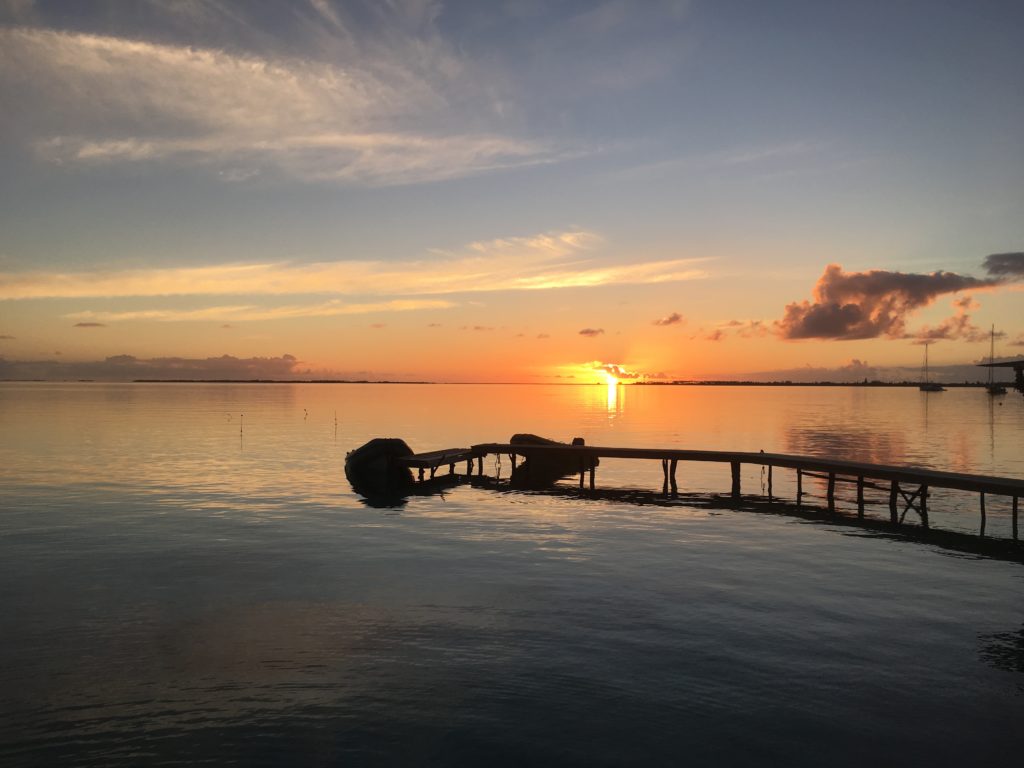
Our first night on Fakarava we found a cute little crepe restaurant with a great view of the sunset, wine and beer glasses in hand.

These sharks lived in the shallow waters right in front of the crepe restaurant. They were permanent fixtures. What can I say? You get used to them!
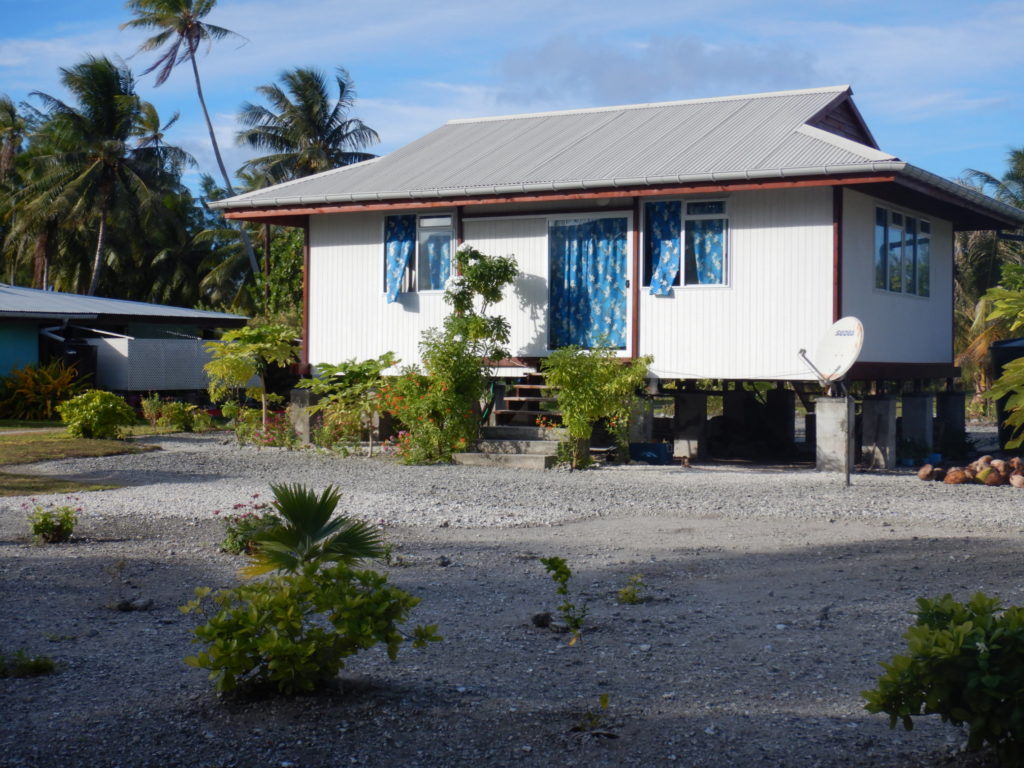
Many of the homes were built up on foundations well off the ground, since there really is no “going to higher ground” when the seas rise
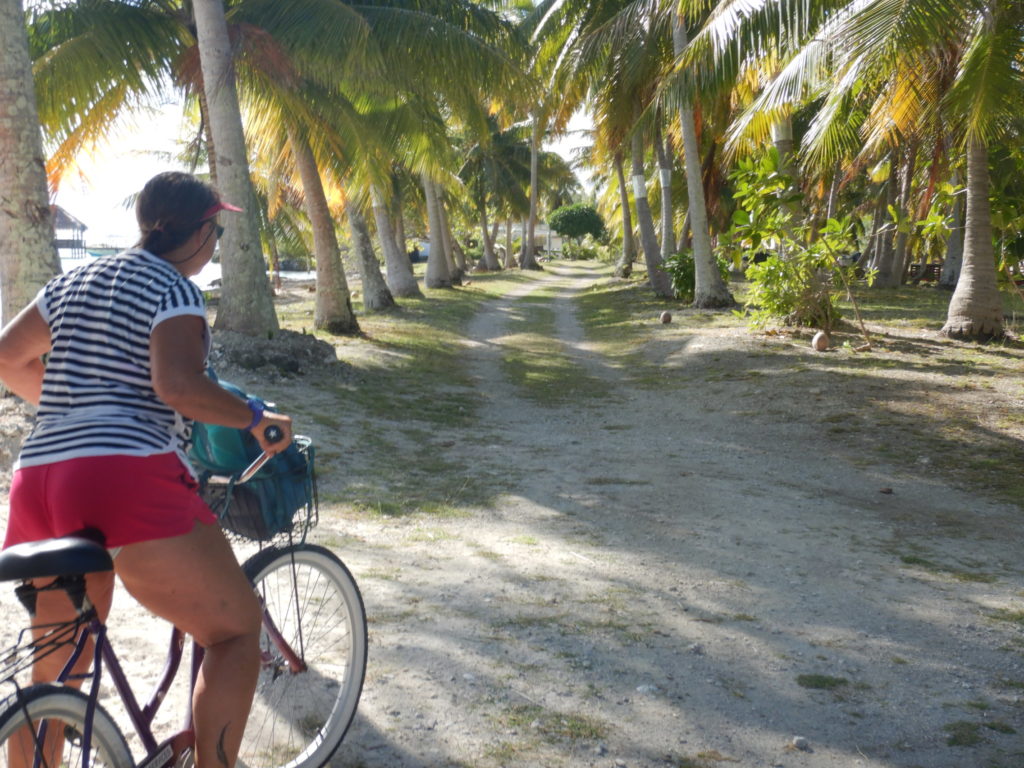
An easy way to get around was bicycling, since the motus are all flat and most aren’t very big. We were able to rent bikes from the local yacht services guy and we got around pretty well

Hardly any food, except maybe coconuts and vegetables from some very well tended vegetable gardens, is available in the Tuamotu. As a result, fresh produce is very expensive. This head of cabbage costs 420 francs, which is about $4.20 U.S.

Rick getting the motor going on our dinghy. That motor is very temperamental but I think Rick has finally gotten the hang of most of the tricks of getting it going. Dinghy care is a big thing in the Tuamotu because you have to be very careful that you don’t motor over a coral bommie, especially with an inflatable bottom like ours. Our friends ripped a hole in theirs. You have to have someone scouting as you motor along, and only do so when the sun is high in the sky.
The Snorkeling
Our underwater pictures don’t do it justice, but we were just blown away the first time we got into the water. Our friends Scott and Laurie invited a bunch of us from the anchorage out on their boat, which they anchored near a large coral outcropping near the marked channel.
After some great snorkeling near the north pass, Muskoka, Harlequin and Cool Change sailed our boats 30 nm or so down to the south pass, known the world over as a prime diving spot to be with …. sharks! There is a dive center down there that coordinates dive trips, including night dives, to watch the literally hundreds of sharks in the pass. We didn’t dive, but instead, we did something called drift snorkeling. You motor your dinghy well into the pass on an incoming tide and then jump in with your snorkeling gear on, hold on to the dinghy painter, and float in with the current, watching all the fish and sharks while you are at it. What a ball! The sharks mostly ignored us, and besides, it is said, they mostly feed at night and this was during the day. Schools of hundreds of neon blue fish, for example, would swim by us like we weren’t even there. I especially liked when we got past the deep section where all the sharks are, and found ourselves moving very quickly over multicolored, multishaped coral about 6 feet below us, with all the tropical fish swimming in and out of their hiding places. If you don’t move, and just let the current carry you, the fish act like they don’t see you so they don’t swim away, and you get to see everything. It was glorious. If I had seen this when I was a young girl, I don’t think you could have kept me from becoming a marine biologist. The underwater world is just so incredibly fascinating.
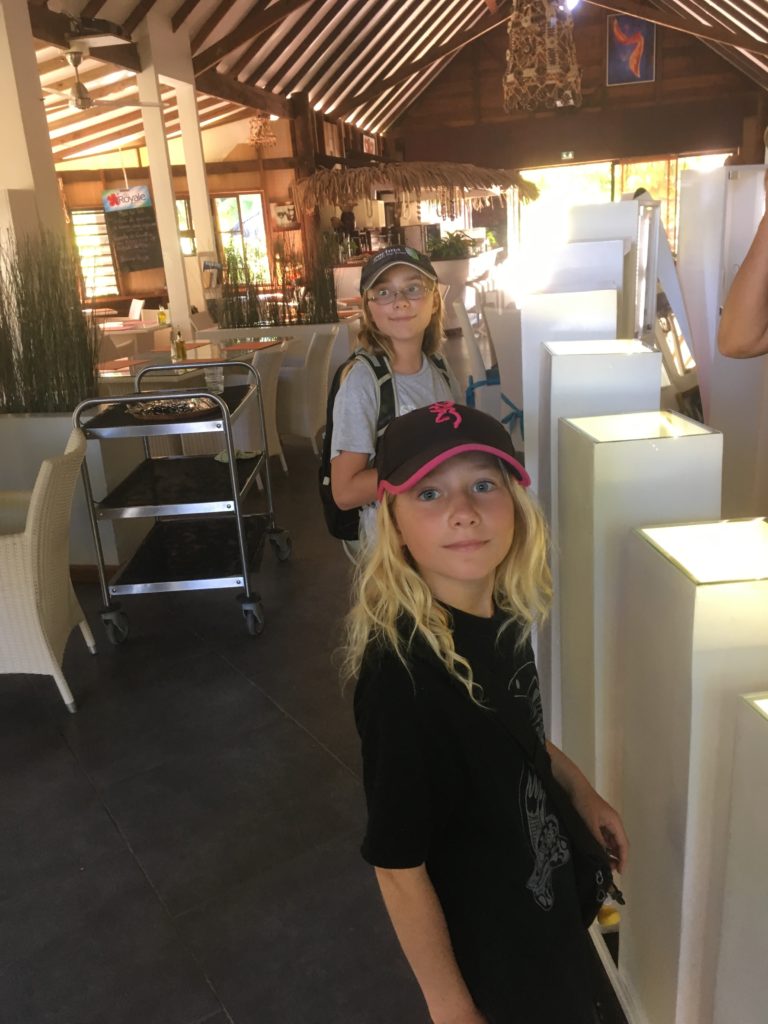
Meet Naomi and Zoe, the very smart and precocious daughters of the “Biology Family Afloat,” whose parents are both marine biologists and are sailing with their daughters around the world, snorkeling and diving wherever they go. Lucky girls!

The dive center, restaurant and bar at the south Fakarava anchorage at night. Getting back to our sailboat at night from this place was tricky, as the route is not marked and the way is full of coral bommies.
Black Pearls
We had heard that the Tuamotu were the place to buy black pearls, so we headed off to visit a couple of pearl farms on Fakarava and see how they are cultured.
The black pearls are cultured painstakingly by hand by planting a round piece of shell wrapped in a small piece of colorful oyster mantle inside the stomach of an oyster and letting it brew for 18 months in the ocean. Once it is farmed, if the resulting cultured pearl is perfect, it is taken out and another, larger piece of shell wrapped in mantle is put in its place for another 18 months until you have a yet bigger pearl. This process can be repeated up to four times, resulting in large, very expensive pearls if they manage miraculously to come out unflawed.
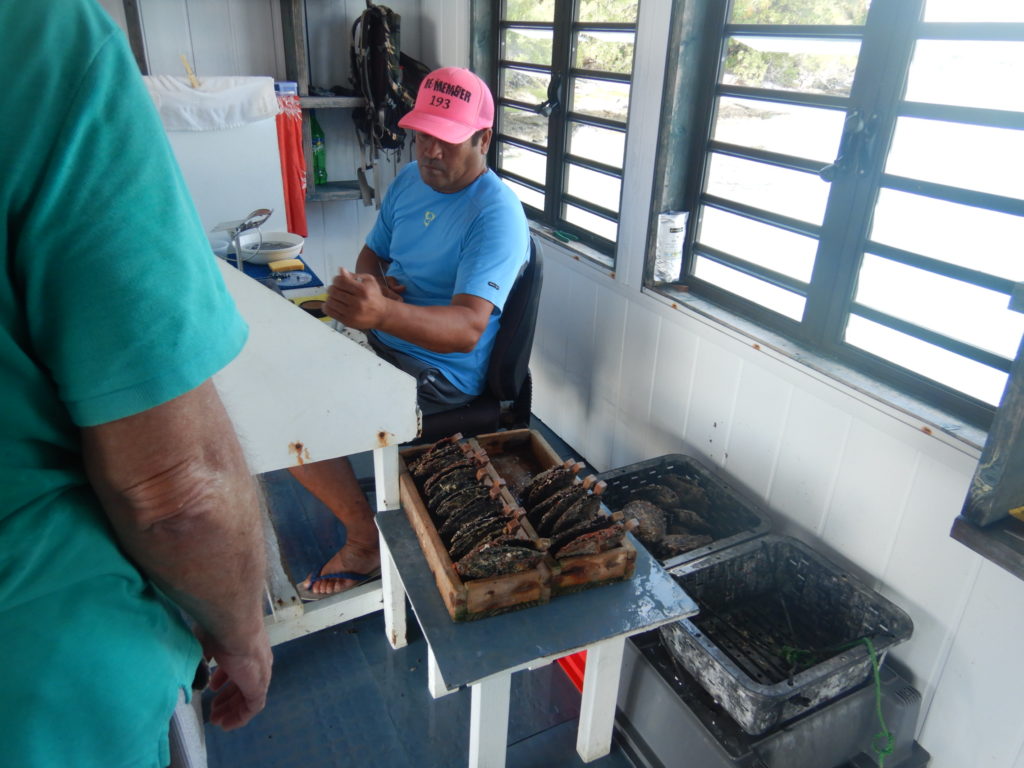
The highly trained and sought-after specialist at work, removing the pearl from the oyster and replacing it with another mother of pearl if warranted

The charming young pearl farm presenter, who explained to us how pearls were cultured. I picked one of those oysters from the table and he opened it to find a beautiful black pearl inside -not everyone was so lucky. I got to keep my pearl. They added a pendant to it and now it hangs around my neck!
Toau
We wanted to go to another atoll before we left the Tuamotu but time was closing in on us before we had to leave if we wanted to get to Tahiti for the Rendezvous, an event planned for all the sailors who had crossed the Pacific this spring. We didn’t want to miss that. So, we chose to move over to another atoll close by, called Toau. Actually, the pass we entered was called a “false pass.” You couldn’t actually enter the lagoon from there, but only get through part of reef and then anchor between motus. It was supposed to be another great snorkeling spot, but by the time we got there, the weather had changed and the wind and current were so strong that we just grabbed a mooring ball and held on tight. The second day, we finally got to shore, where it was rumored that a couple named Valentine and Gaston would be welcoming. They owned the entire motu, which included a coconut plantation, and had previously run a pearl farm until the work got too much for the two of them.
What an interesting couple were Valentine and Gaston! They told us they would make a lobster dinner for us the next night for $40 U.S. per person. It was worth every penny. It was the best meal we have had since we arrived in French Polynesia. She served a delicious focaccia for appetizers, and Poisson Cru (like ceviche but with coconut milk), fish nuggets encrusted in coconut, all the lobster you could eat, and moist coconut cake for dessert. He pulled the live lobster out of his trap, cut them in half while alive, doused them with butter and garlic, and grilled them on a wood fire.
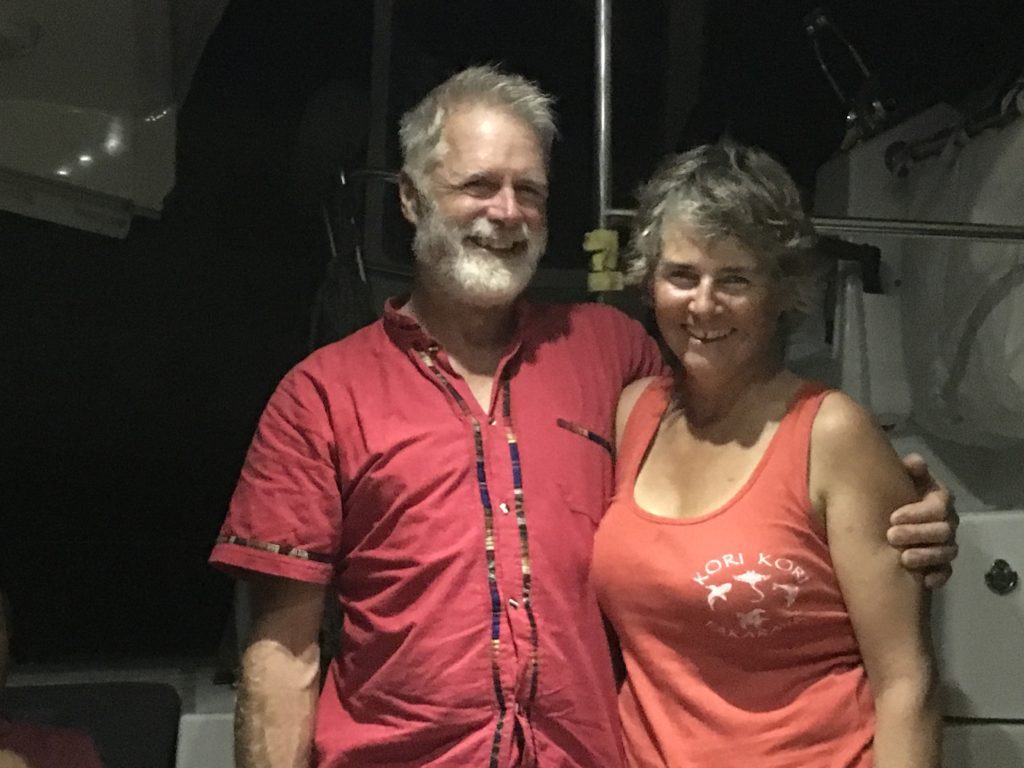
Lisa and Henk from Harlequin, with whom we have reunited in several anchorages since arriving in French Polynesia. They joined the lobster dinner that night.
Six of us had dinner with Valentine and Gaston at this beautiful table setting. After dinner, they taught us how to play Bocce ball, then taught Lisa and I some dancing, then played the yukelele and bass (made from a chord, a bucket and a wooden rod) and sang traditional Marquesan songs for us. Crew from other boats from the anchorage trickled in, and before we knew it, we were a group of about 20, partying Marquesan-style well into the night.
We hated to leave the next day. We would have liked to enjoy their company for much longer. Cruising often makes you wish you had made no commitments whatsoever so you could just endlessly enjoy the moment. Nevertheless, we reluctantly left the anchorage the next day, bound for 200 miles away to Tahiti.

